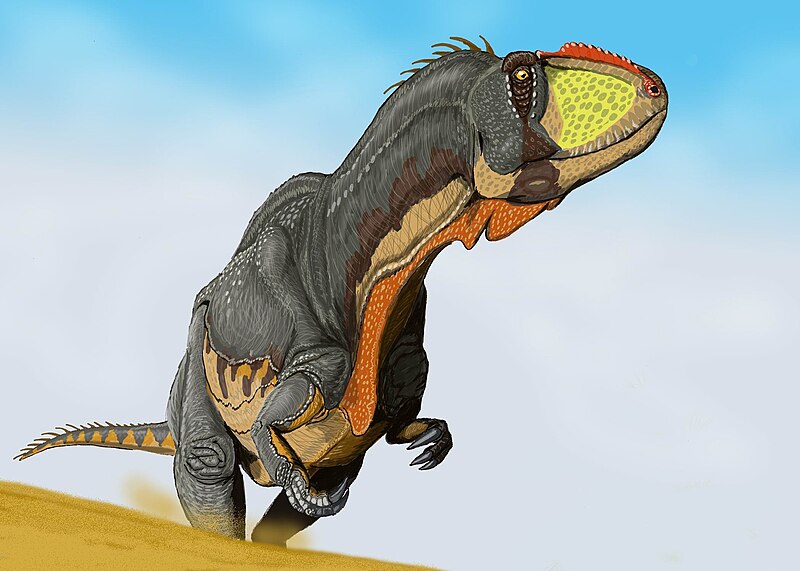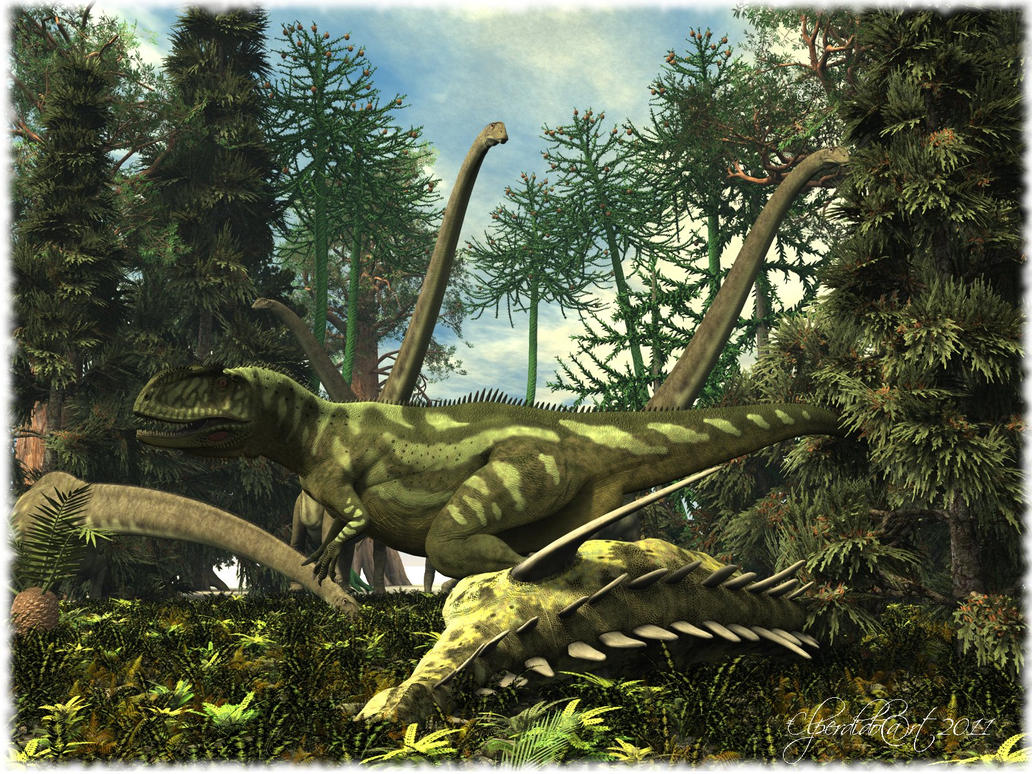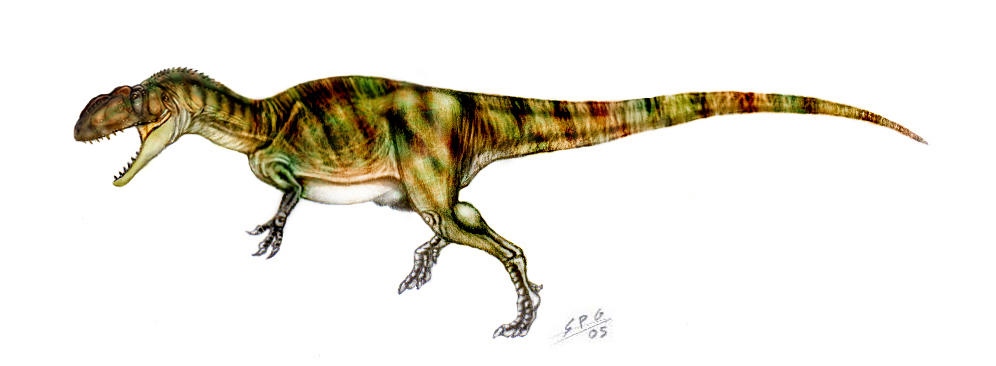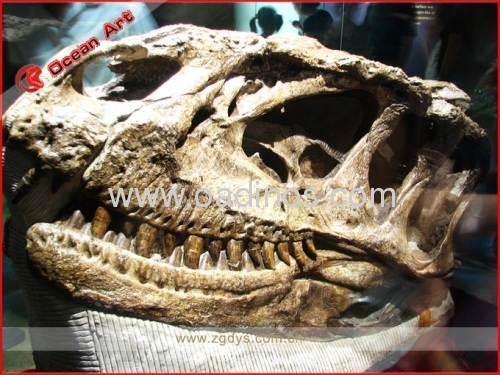[Recent Entries][Archive][Friends][User Info]
| January 25th, 2013 | |
|---|---|
| 12:55 pm [industrialterro] [Link] |
Yangchuanosaurus Янгчуанозавр (Yangchuanosaurus) — крупный хищный динозавр позднеюрской эпохи, живший около 161-151 миллионов лет назад. Родственник аллозавра, принадлежит к эндемичному семейству восточноазиатских аллозавроидов Sinraptoridae. Самый крупный хищный динозавр из китайских юрских отложений. Происходит из оксфордских слоев формации Shangshaximiao в Сычуане. Отличается высоким коротким черепом, с парой гребней над носовыми костями. Остистые отростки спинных позвонков высокие, образуют небольшой «парус» (вероятно, как приспособление для крепления сильных мышц). Известен по двум относительно полным скелетам разного размера. Меньший скелет (животное длиной около 8 метров, череп длиной 78 см) принадлежит, вероятно, невзрослой особи. Этот скелет стал голотипом типового вида (Y. shangyouensis), описанного в 1978 году группой китайских палеонтологов. Название рода дано в честь известного китайского палеонтолога Янг Чуана (Ян Чунзяна). Второй скелет, принадлежавший особи до 11 метров в длину (череп 1,1 метра в длину, вес мог достигать 3 тонн), описан в 1983 году как второй вид — Yangchuanosaurus magnus. Сейчас обычно оба экземпляра объединяют в один вид. Янгчуанозавр — охотник за крупными завроподами, такими как маменчизавр. По своему образу жизни он был схож с североамериканскими аллозаврами. Yangchuanosaurus is an extinct genus of metriacanthosaurid theropod dinosaur that lived in China during the late Oxfordian (and possibly Kimmeridgian) stage of the Late Jurassic, and was similar in size and appearance to its North American contemporary, Allosaurus. It hails from the Upper Shaximiao Formation and was the largest predator in a landscape which included the sauropods Mamenchisaurus and Omeisaurus as well as the Stegosaurs Chialingosaurus, Tuojiangosaurus and Chungkingosaurus. Dong et al. (1978) named Yangchuanosaurus shangyouensis on the basis of CV 00215, a complete skull and skeleton which was collected from the Shangshaximiao Formation, near Yongchuan, Yongchuan District, Sichuan. It dates to the Oxfordian or the early Kimmeridgian stage of the Late Jurassic period, about 161.2-154 million years ago. It was discovered in June 1977 by a construction worker during the construction of the Shangyou Reservoir Dam. A second species from the same locality, Y. magnus, was named by Dong et al. (1983) on the basis of CV 00216, another complete skull and skeleton. A detailed revision of tetanuran phylogeny by Carrano, Benson & Sampson (2012) revealed that both species are cospecific. Dong et al. (1978) and Dong et al. (1983) differentiated these species primarily on the basis of size. In addition, Dong et al. (1983) noted that the maxilla of Y. magnus has an additional fenestra within the antorbital fossa, whereas Y. shangyouensis possessed only a fossa in this location. However, it is considered to be an intraspecific, possibly ontogenetic, variation. Furthermore, the apparent difference in cervical vertebral morphology can be explained by comparing different positions within the column. Hence, the holotypes of the two species of Yangchuanosaurus are effectively identical, and their codings are identical in Carrano et al. (2012) matrix. Gregory S. Paul (1988) regarded this genus as the same as Metriacanthosaurus, but this has not been supported. Carrano et al. (2012) assigned a third specimen to Y. shangyouensis. CV 00214 is represented by a partial postcranial skeleton lacking the skull. It was collected in the Wujiaba Quarry, near Zigong city, Sichuan, from the lower part of the Shangshaximiao Formation. CV 00214 was initially listed by Dong et al. (1978) in a faunal list as a new species of Szechuanosaurus, Szechuanosaurus "yandonensis". There is no description or illustration of it, making S. "yandonensis" a nomen nudum. Later, Dong et al. (1983) described it, and assigned it to Szechuanosaurus campi, a dubious species which is known only from 4 teeth. Carrano et al. (2012) noted that CV 00214 can't be assigned to S. campi because the holotype materials of S. campi (IVPP V.235, V.236, V.238, V.239; teeth) are non-diagnostic and no teeth are preserved in CV 00214. A recent restudy of CV 00214 by Daniel Chure (2001) concluded that it represented a new taxon, informally named "Szechuanoraptor dongi", into which Szechuanosaurus zigongensis should also be subsumed. However, the most recent revision (by Carrano et al. (2012)) suggested that CV 00214 and "S." zigongensis can't be cospesific as there are no autapomorphies shared between them, and the latter derives from the underlying Xiashaximiao Formation. A phylogenetic analysis found CV 00214 to be most closely related to Y. shangyouensis, and thus the former is assignable to it. Furthermore, Szechuanosaurus zigongensis was found to be closely related to Y. shangyouensis and therefore was designated as the second species of Yangchuanosaurus. Yangchuanosaurus zigongensis is known from four specimens including ZDM 9011 (holotype), a partial postcranial skeleton; ZDM 9012, a left maxilla; ZDM 9013, two teeth and ZDM 9014, a right hind limb. It was first described by Gao (1993), and all specimens were colleted from the Middle Jurassic Xiashaximiao Formation in the Dashanpu Dinosaur Quarry of Zigong, Sichuan. A phylogenetic analysis by Carrano et al. (2012) found Yangchuanosaurus to be the basalmost known metriacanthosaurid and the only non-metriacanthosaurine metriacanthosaurid.
Репродукции (1, 2, 3, 4, 5, 6, 7, 8, 9, 10):
Размеры тела в сравнении с человеком:
Ископаемые останки и реплики (1, 2, 3, 4, 5, 6, 7, 8):
Tags: Вымершие рептилии, Юра, авеметатарзалии, архозавроморфы, архозавры, диапсиды, динозавроморфы, динозавры, карнозавры, синрапториды, тероподы, ящеротазовые |


















